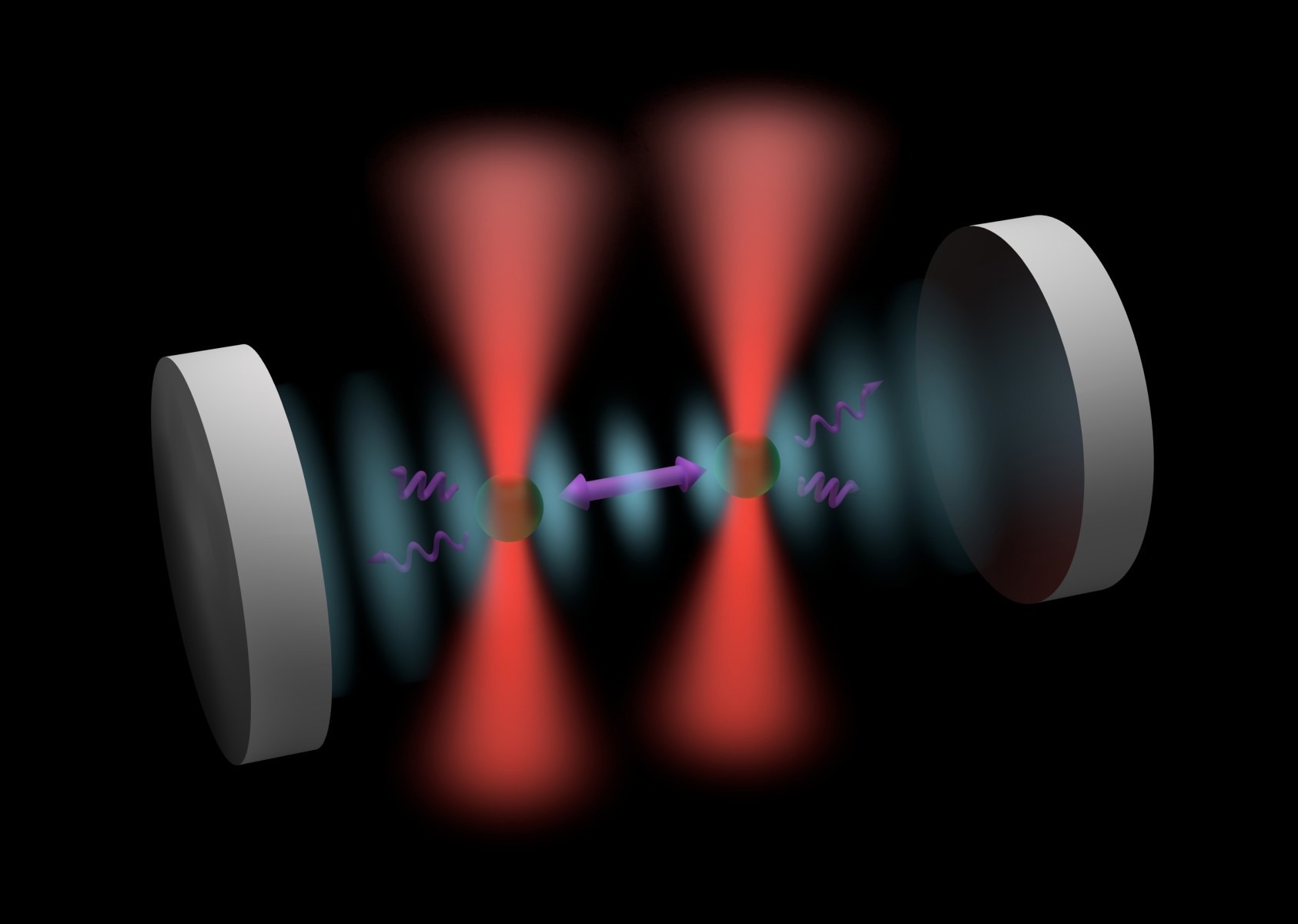Reviewed by Lexie CornerMar 4 2024
The inquiry into the precise location of the demarcation line separating classical and quantum physics has been a longstanding focus of contemporary scientific investigation.
 Two optically trapped nanoparticles are coupled together by photons bouncing back and forth between mirrors. The image shows two nanoparticles (green) trapped by optical tweezers / laser beams (red) and placed in between two mirrors (white), which form an optical cavity (periodic blue blobs). The photons scattered by the nanoparticles (squiggly purple arrows) are trapped in the cavity, resulting in an interaction between the two nanoparticles (straight purple line). Image Credit: The University of Manchester.
Two optically trapped nanoparticles are coupled together by photons bouncing back and forth between mirrors. The image shows two nanoparticles (green) trapped by optical tweezers / laser beams (red) and placed in between two mirrors (white), which form an optical cavity (periodic blue blobs). The photons scattered by the nanoparticles (squiggly purple arrows) are trapped in the cavity, resulting in an interaction between the two nanoparticles (straight purple line). Image Credit: The University of Manchester.
In a recent publication, researchers introduce an innovative framework that could aid in resolving this fundamental question.
The principles of quantum physics dictate the actions of particles on a tiny scale, resulting in occurrences like quantum entanglement, in which the characteristics of entangled particles are intricately connected in a manner that defies explanation by classical physics.
Research in quantum physics improves the understanding of physics and provides a more comprehensive view of reality. However, the minuscule scales at which quantum systems function pose challenges in their observation and study.
Since the turn of the 20th century, scientists have been able to study quantum phenomena in larger objects—from subatomic particles like electrons to molecules composed of hundreds of atoms.
Recently, the area of levitated optomechanics has been focusing on manipulating high-mass micron-scale objects in a vacuum to explore the boundaries of quantum phenomena. The goal is to investigate the validity of quantum principles in objects significantly heavier than atoms and molecules.
Nevertheless, as the mass and size of an object increase, the interactions responsible for intricate quantum characteristics, like entanglement, are compromised by environmental factors, leading to the classical behavior that is commonly observed.
However, a new method to address this issue has been developed by the team co-led by Dr. Jayadev Vijayan, who heads the Quantum Engineering Lab at The University of Manchester. Collaborating with scientists from ETH Zurich and theorists from the University of Innsbruck, the team conducted an experiment at ETH Zurich, which was subsequently published in the journal Nature Physics.
To observe quantum phenomena at larger scales and shed light on the classical-quantum transition, quantum features need to be preserved in the presence of noise from the environment. As you can imagine, there are two ways to do this- one is to suppress the noise, and the second is to boost the quantum features. Our research demonstrates a way to tackle the challenge by taking the second approach. We show that the interactions needed for entanglement between two optically trapped 0.1-micron-sized glass particles can be amplified by several orders of magnitude to overcome losses to the environment.
Dr. Jayadev Vijayan, Head, Quantum Engineering Lab, The University of Manchester
The researchers positioned the particles amidst two extremely reflective mirrors, creating an optical cavity. Consequently, the photons emitted by each particle reflect back and forth between the mirrors numerous times before exiting the cavity, resulting in a notably increased likelihood of interacting with the other particle.
Remarkably, because the optical interactions are mediated by the cavity, its strength does not decay with distance meaning we could couple micron-scale particles over several mm.
Johannes Piotrowski, Study Co-Lead, ETH Zurich
The researchers positioned the particles amidst two extremely reflective mirrors, creating an optical cavity. Consequently, the photons emitted by each particle reflect back and forth between the mirrors numerous times before exiting the cavity, resulting in a notably increased likelihood of interacting with the other particle.
The results indicate a major step forward in comprehending basic physics and showing potential for real-world use, especially in sensor technology for environmental monitoring and offline navigation.
The key strength of levitated mechanical sensors is their high mass relative to other quantum systems using sensing. The high mass makes them well-suited for detecting gravitational forces and accelerations, resulting in better sensitivity. As such, quantum sensors can be used in various applications in various fields, such as monitoring polar ice for climate research and measuring accelerations for navigation purposes.
Dr. Carlos Gonzalez-Ballestero, Assistant Professor, Technical University of Vienna
Piotrowski added, “It is exciting to work on this relatively new platform and test how far we can push it into the quantum regime.”
The researchers will now integrate the new capabilities with established quantum cooling methods to progress toward verifying quantum entanglement. Successfully achieving entanglement of levitated nano- and micro-particles can bridge the divide between the quantum realm and everyday classical mechanics.
Dr. Jayadev Vijayan’s group at the Photon Science Institute and the Department of Electrical and Electronic Engineering at The University of Manchester will continue their work in levitated optomechanics, using multi-nanoparticle interactions for quantum sensing applications.
Journal Reference:
Vijayan, J., et al., (2024) Cavity-mediated long-range interactions in levitated optomechanics. Nature Physics. doi.org/10.1038/s41567-024-02405-3.